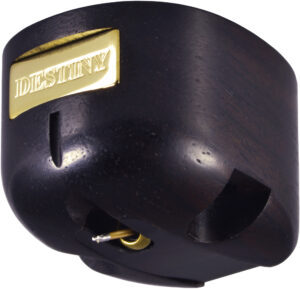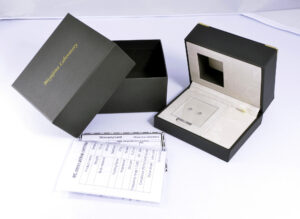How do you want your music? Some classical fans may want less micro detail in favor of a more laid back, macro perspective to take in the entire orchestra, perhaps yielding a more judicious treatment of delicate woodwinds amidst the panoramic strings and brasses. To some lieder fans, tonal magnetism and fluidity of the human voice is non-negotiable, while piano fans may prefer a more immediate and dynamic presentation. There are cartridges out there known to capture one or more of these attributes, but are there any known to do it all? Every so often a cartridge manufacturer is able to create one that manages to impart a more well balanced presentation on classical music than most, albeit at a price not too many can afford, e.g., the Top Wing Suzaku. Rarer still is an artisanal effort on a small scale culminating in a design that turns the industry on its head. The $7,600 Miyajima Laboratory Destiny from Japan is one such precious example.
Miyajima Laboratory headquarters is in its own three-story building in the city of Fukuoka, the major Japanese port city closest to the Korean Peninsula. The company is run by two generations of the family: Noriyuki, company founder and owner, plus a son and a daughter, along with three other staff. Currently, the company offers twenty-one products, including eight stereo cartridges, six mono cartridges, two stereo step-up transformers, one mono SUT, a passive preamp, an output-transformerless monoblock amplifier, a tube full-function preamp, and one intriguingly unique two-phono input active gain unit with volume control. The Miyajima Destiny moving-coil cartridge is created and assembled by 70-year-old company founder Noriyuki Miyajima himself. Noriyuki is also primarily responsible for developing new designs and updating exiting models. In his response to my question, “I do all the difficult work.”
Miyajima Laboratory’s biggest claim to fame is the use of a patented technique called Cross-Ring that places the cantilever fulcrum at the center of the iron coil, versus placing it at the fore or aft, thus dispensing with the use of a connecting wire while harnessing the full magnetism of the core as excited by the cantilever.
Of the eight stereo cartridges, six are made of African Blackwood. Noriyuki chose this wood for its “very high specific density.” And since the wood chosen is already “very old African Blackwood, the body doesn’t change much over the years.” The tracking force on the Destiny is set to 2.5 grams, slightly heavier than most moving coils. He claims that it is done to increase the ratio of the weight of the cantilever to that of the body for tracking stability. In fact, he said he made it a point to make the body “as heavy as possible.” The Destiny’s natural wood body is 47% heavier than the 9 grams lightweight composite materials body of the $17k Top Wing Suzaku that I reviewed in summer of 2020. Still, most $1,000+ tonearms of the day are rated to handle heavy cartridges such as the Destiny.
It is perhaps noteworthy to mention there are two other cartridges among the Miyajima line with a specified tracking force of 3 grams, namely the $4,975 Cameroon Ebony SabotenL and the $3,100 African Blackwood Shilabe. The Shilabe employs a Shibata stylus, thus understandable for its heavier tracking ability, but the SabotenL is Line Contact, so its 3 grams tracking specification is somewhat puzzling. On the two cartridges’ characteristics, Miyajima Laboratory U.S. importer Robin Wyatt of Robyatt Audio commented, “The Shilabe is very warm and rich and fav of those who like the ‘old’ sound. The ‘new’ sound is the SabotenL.”
The Destiny employs the Line Contact stylus. On assigning Line Contact and Shibata styli for the various models, Noriyuki offers the following: “Line contact styli have a slightly longer life than Shibata stylus. The Shibata stylus distributes pressure by increasing the contact area of the LP. It’s hard to decide which one is better, but since the line contacts are smaller than Shibata, we chose line contacts [for some models] to reduce the mass.”
The lowest-priced Miyajima stereo cartridge adorned with a Line Contact tip is the TakumiL at $2,675, which is housed in the African Blackwood no less, and is specified to track at a “mere” 2.3 grams. Also being given the same wood body are the $5,995 Madake and the $3,700 Kansui, both Shibata-tipped, while the $1,995 Takumi L employs a bonded elliptical stylus.
What really perplexes me is the sheer number of mono cartridges being offered by the company. I’d understand if there were one or two models available to address the need of that small sect of music lovers who listen to one-channel music. Six models, with the top model topping out at $3,500, seems almost incomprehensible. Among them is one for 78rpm LPs. Does there exist a market robust enough for Miyajima to justify channeling resources into offering six mono cartridges? Are there enough customers preferring the monophonic sound of music recorded and produced with yester years’ technologies over music made in the modern age with potential for greater richness in image specificity and ambiance retrieval?
Robin: “I sell hundreds of mono cartridges a year, dozens of mono step up’s and true mono phono stages. Think of how many mono LP’s were produced, the standard of music and the sound quality that until recently has not been surpassed. Many mono jazz albums sell for many multiples of dollars over stereo versions. I played you a mono classical album years ago in my demo room. If you remember you were speechless. (No recollection. Sorry. –Pub.) Think of all the mono reissues. No demand would mean no reissues. The Beatles Mono box set out sold anything Beatles- ever! Nine of the Beatles thirteen studio albums were mono. Both the Beatles and George Martin had no time for stereo. If I play you Miles Davis “Kind of Blue” in stereo and mono I will bet you a good Cantonese dinner you pick the mono!
You need to try a mono cartridge. If you have never used a true mono cartridge with a mono LP you have not heard what LP can actually sound like. Listen and ye shall believe” Noted.
- (Page 1 of 2)
- Next page →







Constantine,
Thank you for this articulate and informative review. Could you comment on how the Destiny performed on the Glanz MH 1200s? Absolute and relative to the other tonearms?
Thanks, Geoff
Hello, Geoff,
Thank you for your inquiry and your readership. I thought the Glanz MH-1200S induced more powerful dynamic contrasting from the Miyajima Destiny, at the same time rendering a Koetsu Jade Platinum-like tonal vividness.
However, since I don’t have the Glanz MH-1200S anymore, I can’t make more updated and definitive comparison of its performance against other comparably priced tonearms.
Thanks Constantine. I have the Glanz MH-1200S and my experience agrees with yours on inducing powerful dynamics from a cartridge. Sometimes a bit too much. My Koetsu RSP loses a bit of its mellow nature. I will experiment with some headshells too as some users have reported better results using different head shells than the stock Glanz.
You’re very welcome, Geoff.
Also, I would suggest experimenting with different resistive loading, as well as cabling. The Glanz headshell is quite good.